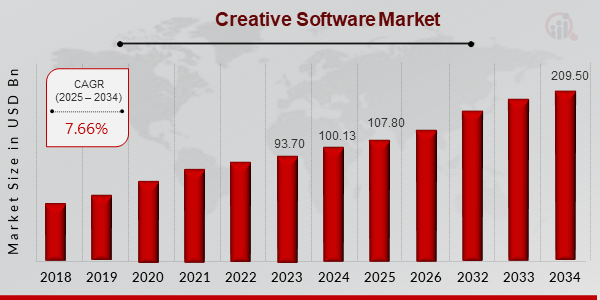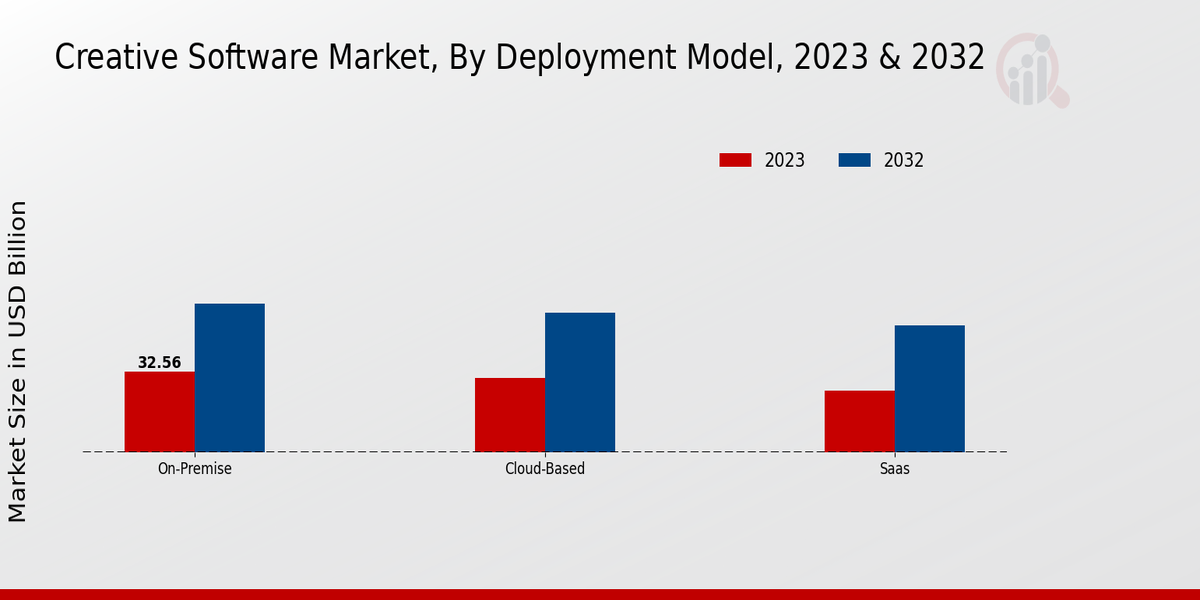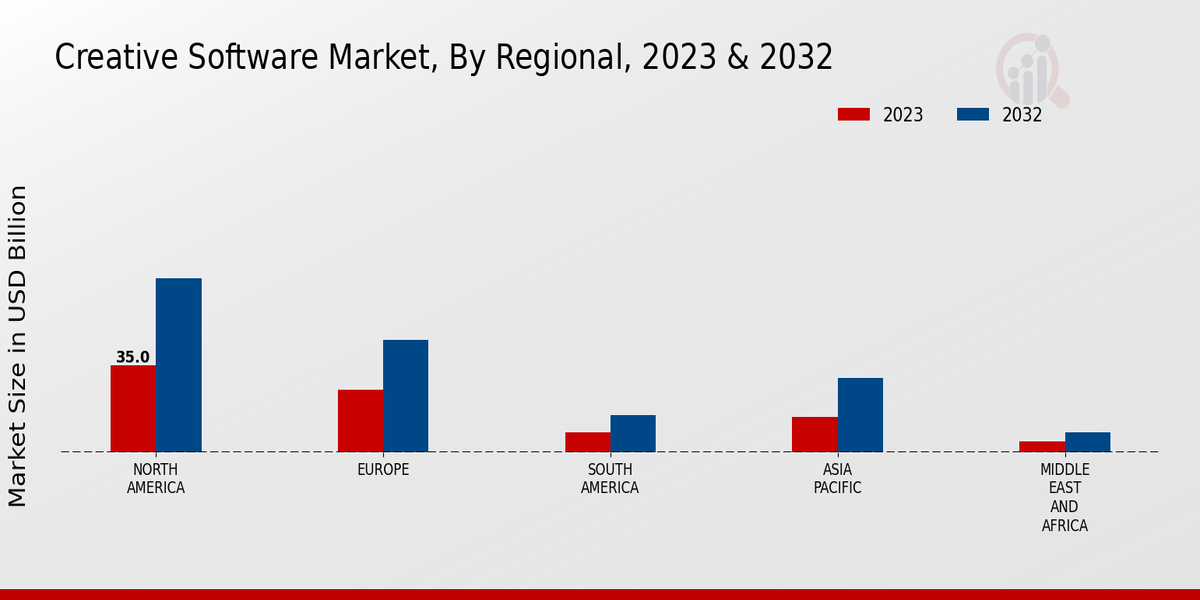Creative Software Market Overview
Creative Software Market is projected to grow from USD 107.80 Billion in 2025 to USD 209.50 Billion by 2034, exhibiting a compound annual growth rate (CAGR) of 7.66% during the forecast period (2025 - 2034).
Additionally, the market size for Creative Software Market was valued at USD 100.13 billion in 2024.
Key Creative Software Market Trends Highlighted
The creative software market on the global market scenario is expanding, propelled by technology changes, at a rapid rate. The rise in such Cloud solutions, the penetration of the mobile technologies’ market, and the demand for visual content are among the factors that drive this market growth. Also new trends tend to appear on the market for example – tools integrated with artificial intelligence (AI) and VR/AR technologies’ integration. These developments present opportunities for companies to find new ways of customer interaction and improve the creativity of the company. It is necessary to concentrate on developing new software products that meet the requirements of the creative individuals to be able to seize these opportunities.
Figure 1: Creative Software Market size 2025-2034

Source: Primary Research, Secondary Research, MRFR Database and Analyst Review
Creative Software Market Drivers
Growing Demand for Digital Content Creation
The rising popularity of digital content across various platforms, such as social media, streaming services, and e-commerce websites, has fueled the demand for creative software. Businesses and individuals alike require tools to create engaging and visually appealing content to capture the attention of their target audience. Creative software empowers users to produce high-quality images, videos, animations, and other digital assets that resonate with their audience and drive engagement.This growing demand for digital content creation is a significant market driver for the Global Creative Software Market Industry.
Advancements in Artificial Intelligence (AI) and Machine Learning (ML)
The integration of AI and ML technologies into creative software has revolutionized the industry. AI-powered tools automate repetitive tasks, enhance workflow efficiency, and provide real-time feedback to users. ML algorithms analyze user behavior and preferences, offering personalized recommendations and suggestions. These advancements empower creators to produce more innovative and impactful content, leading to increased adoption of creative software solutions.
Shift towards Cloud-Based Services
The transition towards cloud-based creative software has gained momentum in recent years. Cloud platforms offer several advantages, including accessibility from anywhere with an internet connection, scalability to meet fluctuating demands, and reduced hardware and maintenance costs. Cloud-based services also facilitate collaboration among team members, enabling seamless project execution and efficient content production. This shift towards cloud-based solutions is a key market driver for the Global Creative Software Market Industry.
Creative Software Market Segment Insights
Creative Software Market Deployment Model Insights
The Deployment Model segment of the Global Creative Software Market shows a diverse and evolving landscape, with substantial contributions from various deployment types. In 2023, the overall valuation of the Global Creative Software Market, standing at 86.38 USD Billion, highlights significant opportunities within this market. Among the different deployment methods, the On-Premise model is valued at 32.56 USD Billion, illustrating its notable presence as a preferred choice for organizations requiring complete control over their software and data in-house. This model demonstrates a majority holding due to its capability of meeting specific compliance and security needs in various industries. Contrastingly, the Cloud-Based deployment method has a valuation of 29.92 USD Billion, showcasing a strong demand correlating with the increasing trend towards flexibility, scalability, and lower upfront costs. This model allows organizations to access software solutions seamlessly over the internet, fostering collaboration and enabling remote work capabilities, which have become critical in modern workplaces. Additionally, the SaaS (Software as a Service) model is valued at 24.90 USD Billion in 2023, gaining traction as businesses are increasingly vigilant about reducing IT infrastructure costs and improving service delivery. SaaS is significant in the context of the Global Creative Software Market, as it typically provides continuous updates and high accessibility, making it a popular choice for creative professionals looking for cost-effective solutions. The dynamics of the market emphasize the importance of these deployment strategies, with each method catering to different organizational needs. The continuous rise in digital transformation, along with the increasing demand for creative solutions across various sectors, further drives these segments' growth. As the Creative Software Market evolves, the ongoing trends of remote work, software accessibility, and customer-centric approaches ensure that the Deployment Model will remain a critical area of focus for both companies and consumers alike. Such variations offer distinct advantages that align with current market demands, cementing their positions in the segments' revenue contribution and ensuring robust growth in the upcoming years. Overall, the analysis of the Deployment Model within the Global Creative Software Market illustrates a thriving ecosystem, influenced by a blend of technological advancements and changing consumer preferences.
Fig 2: Creative Software Market Insights

Source: Primary Research, Secondary Research, MRFR Database and Analyst Review
Creative Software Market End-User Industry Insights
In 2023, the Global Creative Software Market, valued at 86.38 USD billion, showcases a diverse End-User Industry landscape, influencing various sectors. The Media and Entertainment sector leverages creative software for content creation and streaming solutions, significantly contributing to market growth. Design and Publishing remains a pivotal industry where innovative tools enhance creative workflows and output quality. Architecture and Engineering benefit from advanced visualization software, ensuring precise project execution. Education has increasingly adopted creative solutions to enhance learning experiences.The Healthcare industry's adoption of creative software facilitates better patient engagement and medical visualization. Manufacturing and Retail sectors utilize creative tools for product design and marketing strategies, driving engagement with consumers. The Global Creative Software Market segmentation reflects a balanced distribution across these industries, highlighting significant opportunities for software innovation and application, driven by the ongoing digital transformation across enterprises. As such, the market statistics underline the growth potential, illustrating how various industries utilize creative tools to enhance efficiencies and engagement.
Creative Software Market Functionality Insights
The Global Creative Software Market revenue has shown significant growth, with expectations of reaching around 86.38 USD Billion in 2023 and further escalating as the year progresses. The Functionality aspect encompasses various critical areas such as Graphics Design, Video Editing, Animation, Music Production, 3D Modeling, Web Design, and other functionalities that play vital roles in the creative process. Graphics Design software, for instance, facilitates visual communication and branding, making it a fundamental tool for businesses. Video Editing remains essential in content creation, especially with the rise in social media and online streaming services, enhancing the demand for efficient editing tools.Animation serves the growing entertainment and advertising sectors, while Music Production software is increasingly significant as music becomes a central component of digital content. 3D Modeling tools are crucial for industries like gaming and architecture, allowing for realistic visualizations. Web Design functionality supports online business growth, ensuring user-friendly experiences. Thus, the combination of these functionalities demonstrates a robust Global Creative Software Market segmentation, with dynamics reflecting trends in digital consumption and the need for compelling audiovisual content, as supported by current Global Creative Software Market data and Statistics.
Creative Software Market Pricing Model Insights
The Global Creative Software Market revenue is expected to reach 86.38 billion USD in 2023, showcasing a robust potential influenced by various Pricing Models. The segmentation within this domain includes several models such as Subscription-Based, Perpetual License, Tiered Pricing, and Pay-As-You-Go. Subscription-Based pricing continues to gain momentum as it offers flexibility and lower initial costs, appealing to a diverse user base from individuals to enterprises. Perpetual License previously held significant sway due to its traditional ownership model, yet the shift towards digital transformation has moderated its dominance.Tiered Pricing facilitates customization, catering to different user needs, and is observed as a preferred choice among businesses seeking scalable solutions. The Pay-As-You-Go model also presents a valuable opportunity, particularly for startups and freelancers, allowing users to pay solely for what they utilize. This diverse pricing landscape underpins the overall market growth, with emerging trends further enhancing user engagement through accessible models tailored to various customer preferences in the Global Creative Software Market.
Creative Software Market Company Size Insights
The Global Creative Software Market, valued at 86.38 USD Billion in 2023, is experiencing noteworthy growth, particularly when analyzed through the lens of Company Size. Small and Medium-Sized Enterprises (SMEs) are pivotal in driving demand, as they increasingly adopt creative software solutions to enhance operational efficiency and stimulate innovation. These enterprises often require cost-effective and scalable solutions, making them a significant contributor to market dynamics. In contrast, Large Enterprises dominate the market due to their substantial budgets and established workflows.They leverage advanced creative software to maintain competitive advantages and facilitate complex project management. The Global Creative Software Market segmentation reveals that both company sizes are essential for market growth, with SMEs representing a significant portion due to their adaptability, while Large Enterprises provide stability and substantial investments in technology. As the industry evolves, emerging trends like increased cloud adoption and AI integration in creative software present lucrative opportunities for both segments, indicating a robust outlook for the Global Creative Software Market revenue in the coming years.
Creative Software Market Regional Insights
The Global Creative Software Market exhibits significant variations across its regional segmentation. In 2023, North America holds a dominant position with a valuation of 35.0 USD Billion, expected to double to 70.0 USD Billion by 2032, highlighting its majority holding in market growth due to advanced technological adoption and extensive content creation industry. Europe follows closely, starting at 25.0 USD Billion in 2023 and reaching 45.0 USD Billion in 2032, driven by a robust demand for multimedia and design software. South America shows potential with a valuation of 8.0 USD Billion in 2023, growing to 15.0 USD Billion by 2032, indicating a significant increase in creative projects within the region.The Asia Pacific region, valued at 14.0 USD Billion in 2023 and anticipated to reach 30.0 USD Billion by 2032, projects strong growth fueled by rising digital transformation initiatives. Lastly, the Middle East and Africa, with a modest starting valuation of 4.38 USD Billion in 2023, is expected to expand to 7.84 USD Billion by 2032, as increasing internet penetration fosters creative software adoption. Overall, the regional insights reveal a dynamic landscape with varying growth drivers contributing to the overall expansion of the Global Creative Software Market revenue.
Fig 3: Creative Software Market Regional Insights

Source: Primary Research, Secondary Research, MRFR Database and Analyst Review
Creative Software Market Key Players And Competitive Insights
Major players in Creative Software Market are constantly striving to gain a competitive edge by investing in research and development to enhance their software capabilities, offering innovative features, and expanding their product portfolios. Strategic partnerships and acquisitions are also common strategies employed by leading Creative Software Market players to strengthen their market position and expand their reach. The Creative Software Market industry is highly competitive, with both established players and emerging startups vying for market share.Adobe, a leading Creative Software Market player, offers a comprehensive suite of creative software tools, including Photoshop, Illustrator, Premiere Pro, and After Effects. Adobe's products are widely used by professionals in graphic design, photography, video editing, and web design. The company's focus on innovation and its strong brand recognition have contributed to its success in the Creative Software Market development. Adobe's Creative Cloud subscription model allows users to access its software suite on a monthly or annual basis, providing flexibility and cost-effectiveness.Corel, another major Creative Software Market Competitive Landscape player, offers a range of software products for graphic design, photo editing, and video editing. Corel's products are known for their user-friendly interfaces and affordable pricing, making them popular among small businesses and individual users. The company's recent acquisition of Parallels, a provider of virtualization software, has expanded its product portfolio and strengthened its position in the creative software market. Corel's focus on providing affordable and accessible software has helped it gain market share and compete effectively with larger players in the industry.
Key Companies in the Creative Software Market Include
- DNEG
- Maxon
- PTC
- Blackmagic Design
- Adobe
- Siemens
- Bentley Systems
- Corel
- IBM
- SideFX
- Serif
- Avid
- Autodesk
- Foundry
Creative Software Market Industry Developments
The global creative software market is projected to reach USD 167.84 billion by 2032, exhibiting a CAGR of 7.66% from 2024 to 2032. The market growth is attributed to the increasing demand for digital content creation across various industries and the growing adoption of cloud-based creative software. Recent advancements in AI and machine learning are further enhancing the capabilities of creative software, making it more accessible and efficient for users. The market is witnessing the emergence of new players and the consolidation of existing ones, with strategic acquisitions and partnerships shaping the competitive landscape. Key players in the market include Adobe, Autodesk, Corel, and Maxon.
Creative Software Market Segmentation Insights
Creative Software Market Deployment Model Outlook
- On-Premise
- Cloud-Based
- SaaS
Creative Software Market End-User Industry Outlook
- Media and Entertainment
- Design and Publishing
- Architecture and Engineering
- Education
- Healthcare
- Manufacturing
- Retail
- Other Industries
Creative Software Market Functionality Outlook
- Graphics Design
- Video Editing
- Animation
- Music Production
- 3D Modeling
- Web Design
- Other Functionalities
Creative Software Market Pricing Model Outlook
- Subscription-Based
- Perpetual License
- Tiered Pricing
- Pay-As-You-Go
Creative Software Market Company Size Outlook
- Small and Medium-Sized Enterprises (SMEs)
- Large Enterprises
Creative Software Market Regional Outlook
- North America
- Europe
- South America
- Asia Pacific
- Middle East and Africa
|
Report Attribute/Metric
|
Details
|
|
Market Size 2024
|
100.13 (USD Billion)
|
|
Market Size 2025
|
107.80 (USD Billion)
|
|
Market Size 2034
|
209.50 (USD Billion)
|
|
Compound Annual Growth Rate (CAGR)
|
7.66% (2025 - 2034)
|
|
Report Coverage
|
Revenue Forecast, Competitive Landscape, Growth Factors, and Trends
|
|
Base Year
|
2024
|
|
Market Forecast Period
|
2025 - 2034
|
|
Historical Data
|
2019 - 2023
|
|
Market Forecast Units
|
USD Billion
|
| Key Companies Profiled |
DNEG, Maxon, PTC, Blackmagic Design, Adobe, Siemens, Bentley Systems, Corel, IBM, SideFX, Serif, Avid, Autodesk, Foundry |
| Segments Covered |
Deployment Model, End-User Industry, Functionality, Pricing Model, Company Size, Regional |
| Key Market Opportunities |
· Growing adoption of cloud based software · Increasing demand for immersive experiences · Integration of AI and machine learning · Expansion into emerging markets · Rise of remote collaboration tools |
| Key Market Dynamics |
Rising demand for digital content, Increased cloud adoption, Technological advancements, Growing use of artificial intelligence, & Subscription based pricing models |
| Countries Covered |
North America, Europe, APAC, South America, MEA |
Frequently Asked Questions (FAQ) :
The Global Creative Software Market is expected to reach a value of 209.50 USD Billion by 2034
The market is anticipated to grow at a CAGR of 7.66% from 2025 to 2034
In 2023, the On-Premise deployment model is valued at 32.56 USD Billion, making it the largest segment in the market.
The Cloud-Based deployment model is projected to be valued at 56.49 USD Billion in 2032.
North America is expected to hold a market value of 70.0 USD Billion by 2032, making it the dominant region.
By 2032, the Asia Pacific region is projected to have a market value of 30.0 USD Billion.
Major players in the market include Adobe, Autodesk, IBM, and Blackmagic Design, among others.
The SaaS deployment model is expected to grow from 24.9 USD Billion in 2023 to 51.34 USD Billion by 2032.
The market faces challenges such as rapid technological changes and intense competition among key players.
There are significant opportunities for growth in cloud-based solutions and innovative creative applications.

















